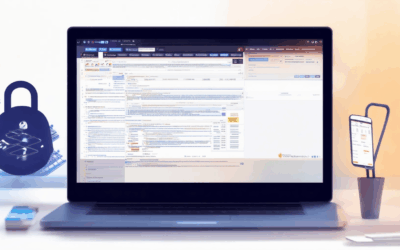In today’s digital age, privacy has become a luxury, with most internet users unaware of just how much of their activity is being tracked. Anonymous browsing offers a way to reclaim control over your online presence, providing a shield against prying eyes. Whether you’re a casual user looking to protect basic privacy or someone seeking maximum anonymity, there are numerous strategies to safeguard your identity. From simple methods to advanced tools, this guide explores the top techniques, tools, and methods to help you stay ahead of the curve.
Key Takeaways
- Use a VPN like BlindBrowser for encrypted internet traffic and enhanced privacy.
- Enable Tor Browser for deep web access and robust anonymity protection.
- Clear your browser history and cookies regularly to minimize data exposure.
- Utilize privacy modes and configure settings to block trackers effectively.
- Combine VPN usage with anonymous browsers for multi-layered security.
- Set up DNS-over-HTTPS for encrypted domain name resolution and reduced tracking.
- Install the HTTPS Everywhere extension to ensure secure browsing experiences.
- Enable Do Not Track settings to limit data collection by websites.

What is the Most Anonymous Way to Browse?
Browsing the web anonymously requires a combination of strategies to protect your identity and online activities. Here’s a structured approach to achieving secure and private browsing:
- Use Incognito or Private Browsing Modes :
Modern browsers like Chrome, Firefox, and Safari offer incognito or private browsing modes. These modes do not save history, cookies, or cache, offering a basic level of anonymity. However, they are not sufficient for high-level privacy protection. - Employ a Reliable VPN Service :
Virtual Private Networks (VPNs) mask your IP address and encrypt your internet traffic. Services like NordVPN provide robust encryption and prevent tracking. We recommend using VPNs paired with other privacy tools for maximum security. - Utilize the Tor Browser :
The Tor Browser is specifically designed for anonymity. It routes your traffic through a network of volunteer nodes, making it difficult to track your online activity. While it’s excellent for deep web browsing, it may slow down certain tasks due to its focus on privacy. - Leverage Tools Like BlindBrowser.com :
Our platform, BlindBrowser.com, offers comprehensive tools and resources tailored for maintaining online privacy. From secure browsing practices to advanced privacy tools, we provide everything you need to stay anonymous while navigating the web. Explore our resources today to enhance your browsing experience.
By combining these methods, you can significantly enhance your online privacy. Remember to always use caution and stay informed about the latest privacy trends to safeguard your digital presence.
How do you do anonymous browsing?
To browse anonymously, consider these steps:
- Use Private Browsing Modes : Enable incognito or private browsing modes on your browser. These modes typically do not save history or cookies.
- Disable Tracking Cookies : Many browsers allow you to block cookies and trackers. Adjust settings to prevent websites from storing your data.
- Ad Blockers : Use ad blockers to reduce tracking capabilities of certain websites and apps.
- Virtual Private Networks (VPNs) : Utilize VPN services to mask your IP address and encrypt your internet traffic. Some popular options include BlindBrowser and ExpressVPN.
- Encrypted Connections : Always use HTTPS when accessing sensitive information to ensure data is encrypted during transmission.
- Avoid Logging In : Refrain from logging into accounts when using public Wi-Fi, as this can expose your information.
- Clear Browser Data : Regularly clear cache, cookies, and history to remove traces of your online activity.
- Use Secure Passwords : Employ strong, unique passwords for every account to enhance protection against unauthorized access.
- Enable Two-Factor Authentication (2FA) : Add an extra layer of security to your accounts to prevent unauthorized login attempts.
- Check Website Policies : Review privacy policies of websites before sharing personal information to understand data collection practices.
For further assistance, visit BlindBrowser for resources and tools tailored to enhance your online privacy.

How to Browse Without Being Tracked
Browsing the web anonymously can be achieved through various methods. Here’s a step-by-step guide to help you stay undetected while browsing:
- Use a Dedicated Anonymity Browser: One of the most effective ways to browse without being tracked is by using a browser designed for privacy. Blind Browser is a popular choice known for its robust security features. It encrypts your traffic and hides your IP address, making it difficult for third parties to track your online activity.
- Enable a VPN: Virtual Private Networks (VPNs) create a secure tunnel between your device and the internet, masking your actual IP address. Many VPNs are available, including free options like ZoroVPN . Just ensure the VPN is reputable to avoid sharing your data with untrustworthy providers.
- Avoid Public Wi-Fi: Public networks often lack encryption, making them risky for browsing activities. Stick to private Wi-Fi networks at home or use your mobile data for greater security.
- Clear Browser History Regularly: Even if you’re using privacy tools, your browser may still retain traces of your activity. Clearing cookies, cache, and browsing history regularly helps minimize the risk of being tracked. Most browsers offer a “Private Browsing” mode, though this doesn’t always prevent tracking entirely.
- Use Incognito or Private Windows: These modes prevent saving history and cookies, offering a basic level of anonymity. However, they don’t encrypt your traffic, so combining them with a VPN or Tor is recommended for maximum privacy.
By following these methods, you can significantly reduce the chances of being tracked while browsing online. Remember to stay vigilant and combine multiple techniques for the best results.

What is the Best Browser to Remain Anonymous?
Browsing the internet anonymously requires careful selection of tools that prioritize privacy and security. Here’s a breakdown of the top browsers and considerations for staying anonymous:
Privacy-Focused Browsers
Tor Browser stands out as a top choice for deep web access and anonymity. Its default configuration blocks trackers and encrypts communications, making it ideal for safeguarding your identity. However, it can be resource-intensive.
Brave Browser combines strong privacy features with ad-blocking capabilities, reducing tracking and data collection. While it doesn’t offer the same level of anonymity as Tor, it’s a solid option for everyday use.
Mainstream Browsers with Privacy Modes
Firefox with the uBlock Origin extension is a versatile choice. Its private browsing mode and extensive privacy settings allow customization to suit your needs. Enabling tracking protection enhances anonymity.
Google Chrome offers a built-in privacy mode, though it lacks some advanced features compared to Firefox. For added security, consider extensions like HTTPS Everywhere.
Minimalistic Options
Vivaldi and Opera also provide decent privacy features. Vivaldi includes built-in ad blockers and tracker blocking, while Opera’s integrated VPN adds an extra layer of anonymity.
Additional Tips
- Enable tracking protection in browsers like Firefox to enhance anonymity.
- Consider using a VPN alongside your browser for added security.
- Regularly clear cookies and cache to minimize data exposure.
By selecting the right browser and configuring it properly, you can navigate the internet with greater confidence in your anonymity.
How Can You Effectively Stay Anonymous While Browsing Online?
Here’s a structured guide to help you stay anonymous while browsing online:
- Use a VPN Service : A Virtual Private Network encrypts your internet traffic, masking your IP address and location. Choose a reputable service like BlindBrowser for enhanced privacy features.
- Enable Tor Browser : The Tor network routes your traffic through multiple nodes, making it difficult to track your online activities. Install Tor Browser for an added layer of anonymity.
- Clear Your Browser History : Regularly clear cookies, cache, and browsing history. Most browsers have private browsing modes, like BlindBrowser’s Secure Mode , which prevents tracking.
- Adjust Browser Settings : Enable features like “Fingerprinting Protection” and disable trackers. Modify your browser settings to block third-party scripts and ads.
- Use Incognito or Private Modes : These modes open in a separate session, leaving fewer traces behind. However, they don’t offer complete anonymity on their own.
- Set Up DNS Over HTTPS : Configure your DNS settings to use encrypted DNS-over-HTTPS to prevent tracking of your domain requests.
By combining these strategies, you can enhance your online privacy and reduce the risk of being tracked. For more detailed guidance, visit BlindBrowser for comprehensive resources.

How Can You Effectively Stay Anonymous While Browsing Online?
Staying anonymous while browsing online requires a combination of strategies, tools, and awareness. Here are some effective methods:
- Use a VPN Service: A Virtual Private Network (VPN) encrypts your internet traffic, making it difficult for third parties to track your online activity. Choose a reputable provider like BlindBrowser’s VPN guide for the best options.
- Enable Tor Browser: The Tor network routes your traffic through multiple nodes, making it nearly impossible to trace your online activities. Install Tor and use it for private browsing sessions.
- Clear Your Browser History: Regularly clear cookies, cache, and browsing history in your preferred browser. This prevents leaving a digital trail of your activities.
- Use InPrivate Browsing Modes: Most browsers offer incognito or private browsing modes that do not save history or cookies. These modes offer basic anonymity.
- Adjust Your DNS Settings: Use DNS-over-HTTPS or switch to a reliable DNS service like Cloudflare or Google Public DNS to enhance privacy and reduce tracking.
- Minimize Data Collection: Enable “Do Not Track” settings in your browser to reduce the amount of data collected by websites. This helps prevent targeted advertising and tracking.
- Use HTTPS Everywhere: Install browser extensions like HTTPS Everywhere to ensure you’re always connected to secure websites, reducing exposure to trackers and malicious sites.
For more detailed guidance, check out BlindBrowser’s comprehensive guide on anonymous browsing .
Conclusion: Combining these techniques creates a robust defense against surveillance. Always stay informed about your online habits and regularly review your privacy settings to maintain maximum anonymity.




